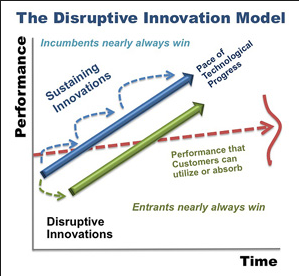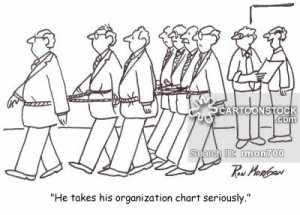Innovation
Growth from Disruptive Innovation
Disruptive Innovation An opportunity for growth
Khattab Al-Ali outlines what businesses should do in the face of disruptive innovation and how they can use them to grow. He recommends not trying to use an innovation that your business model cannot support as well as not following competitors into new business segments if they have expertise you don’t have. He says that listening to customers for what innovations to invest in is a good idea but not to give the customers everything they want on a whim, it does not always make good business sense. He also says when evaluating disruptive innovation you need to not only focus on the standard metrics. Some innovations have consequences that people would not originally think. Finally he says that when addressing the disruptive innovation you should separate it from your main business as to not add risk to your current business.
What do you think businesses should do when evaluating new innovations? How do you think the organization should structure these endeavors?
Why Disruptive Innovation is Not a Strategy
In light of our learning about disruptive innovation and reading about companies like Apple who have used it to their advantage, I found an article claiming that disruptive innovation is not a strategy and that companies should stop striving for it. The author, Soren Kaplan, explains how while many companies are striving to create disruptive innovation strategies, the inherent vagueness of the term makes it a lousy strategy. It’s not a linear method or process, and there is no way to capture how to do it.
The idea isn’t new- originally introduced in 1942 as “creative destruction” by economist Joseph Schumpeter, and it has since become an accepted paradigm, until Jill Lapore started to chip away at the idea. She believes that the concept of disruptive innovation “has been used as an argument for blowing up the broken healthcare and education systems, which minimizes the fact that these long standing institutions are complex social services delivered by human beings, not just stale technologies ready to be displaced by the next big thing.”
The author also goes on to explain how even one of the greatest innovators of all time, Steve Jobs, didn’t try to change the industry when he started Apple. He was quoted saying “When we created the iTunes Music Store, we did that because we thought it would be great to be able to buy music electronically, not because we had plans to redefine the music industry.” Kaplan goes in to cite the founders of Google as well, claiming that they too started with a basic vision, not a grand idea of disruptive innovation and changing the world.
Do you think that disruptive innovation is a sound business strategy? Is it something to strive for or is it just something that happens?
Better Prototyping, Better Software

Given that we will soon be expected to demonstrate progress on our project prototypes, I searched online for software prototyping tips. I found an article at a site called Inc about how develop a strong prototype.
One excellent recommendation made in the article was to develop a prototype with your customer in mind. This point made me recall our prototype revisions in our business analysis class two semesters ago. Our initial prototype was functional, but after reviewing it, we decided that is was more closely aligned with our project team’s needs and wants than with the customer’s. Several more revisions were needed before our prototype became more intuitive and customer-oriented.
Another point made in the article is that “it’s nearly impossible to sell a product without an elegant design.” This became particularly apparent in viewing other groups’ prototype presentations; the groups’ prototypes that made the best impression on the audience were not only functional, but also looked professional and clean. As we all know from using countless applications at work and at school, it is a chore to use poorly designed software, and poor design can seriously impair an application’s functionality.
With these observations in mind, how do you plan to balance your MIS5496 prototype’s functionality with its design? What prototyping lessons did you learn from developing applications in your business analysis class and from overseeing your BA teams in MIS3596?
Is Apple pursuing a strategic move/big investment at the right time?

Apple Orders More Than 5 Million Watches for Initial Run – Digits – WSJ
As we discussed in class proper execution of a product, service, or application can make or break a company. I found this short article about Apple ordering more than 5 million watches for it’s initial run. Now, that may not seem like a huge number for a company like Apple, but we need to keep in mind that this is the first all-new product since the I-Pad. These watches will do much more than just tell time. They can stream live weather reports, reminder notifications, upcoming calender events and more. The base model watch will run around $350+, and the high end model that comes encased in gold looks like it will cost upwards of $4000+. With all that being said I think this watch is an awesome innovative product and if I had the money I eventually would probably purchase one of the low end models. What are your guys thoughts, and also I have a view questions listed below to be answered.
1. What do you think of Apples strategic production forecasting “plan of record?” Do you believe this is what keeps Apple from going under?
2. Do you think Apple is eager to stretch beyond their current abilities?
3. Does Apple understand other people’s constraints and concerns within the market place?
4. Will Apple recover well from setbacks or failures?
Does your Corporate Structure Stifle your Innovation?
http://washingtontechnology.com/articles/2015/01/15/insights-davis-new-corporate-structures.aspx
By removing these “old fashioned” structures, companies:
1) Can spark innovation among employees who no longer feel confined by their organizational role.
2) Create more informal network relationships across organizational boundaries.
3) Distinguish themselves from competitors.
This article argues that old-style, hierarchical organizational structures are detrimental to technological companies. “It creates a straight jacket that makes organization adaptability to changes in the market impossible.” The argument is that the inflexibility of a rigid corporate structure creates a “straight jacket” for firms’ innovation, because employees are always consumed by the operations within their business unit.
Davis also argues that these organizational structures prevent network relationships across organizational boundaries. Creating incentives/rewards for this kind of communication needs to be available to drive cooperation.
Lastly, Davis points out that if all companies have a hierarchical organizational structure, that it is not distinguishing itself from its competitors. A person at Firm A can quit and start working a similar position at Firm B the next week, and would need minimal training because the systems/processes across these organizations are almost identical.
Sustainable Competitive Advantage through IT Innovation
![Printer by Vivian Chen [陳培雯] computer trash photo](https://community.mis.temple.edu/mis4596sec003sp2015/files/2015/02/5204743702_3a48be209b_m_computer-trash.jpg)
Today in class, we debated the commoditization of information technology, an idea largely attributed to author Nicholas Carr. Our debate piqued my interest, so I aimed to investigate what businesspeople and technologists thought about Carr’s bold statement. My search brought me to page 99 of Carr’s personal blog, which gave me insight into just how large of a “splash” the article made in the business and technical communities. Unsurprisingly, the most fiery rebuttals came from heads of organizations centered around IT innovation (“IT ‘Is’ the Business”-type companies). Carr provides a link to an article detailing the manner in which Intel’s CEO “fires back” with an opposing viewpoint. Carr subsequently quotes Bill Gates as proclaiming that IT would not matter only if technology were perfect or simply could not be improved further; both conditions, obviously, do not describe contemporary IT.
In my exploration of the topic, I became more sure of my own stance. Particularly, I dislike Carr’s claim that IT is “no longer a source of advantage at the firm level.” Through innovation, a company can certainly gain a short-lived advantage over other firms. Perhaps what Carr more precisely means (at the risk of putting words in his mouth) is that IT alone does not result in a sustainable competitive advantage, a condition that many of us are discussing in BA4101. In other words, a single IT innovation only results in a limited and brief advantage over rivals.
To prompt further discussion, I offer this question: how can a business encourage and attain sustainable IT innovation? What types of cultural, financial, and motivating factors might promote such an endeavor?
Is Having No Job Titles a Viable Organizational Architecture?
http://www.bloomberg.com/bw/articles/2012-04-27/why-there-are-no-bosses-at-valve
I’ve noticed that many of the most innovative IT companies seem to incorporate some seemingly unorthodox organization architectures. One of the prime examples of this is with Valve Corporation, in which there are no job titles. Whenever there is a new project, employees get to choose which aspect of the project they wish to work on. Valve employees appreciate this approach in that they can get their hands dirty in whichever aspect of the company they want. CEO Gabe Newell provided one example of an animator from the film industry who specialized in just mouth animations. But once he started working at Valve, quickly realized that he was longer confined to working on just mouth animations, but could instead work on whatever animation he wanted. This welcomes creativity among employees.
It may seem like this type of organizational architecture would result in not much work being done, or for there to be work that no one will choose to work on. However, Valve continues to create some of the most innovative and praised games, and their Steam market has proven to be an ingenious business model that benefits both the company and developers. Although not explicitly stated in the article, there are still employees who act as “managers” for projects. There may be no job titles, but there still needs to be some sort of structure and people who can keep track of the work being done.
What do you guys think of this type of organizational architecture? Is it always a viable option, or is it more suited for companies that strive to create innovative products and solutions? I personally think it’s a great approach for sparking innovation and creativity among employees, but also think that most employees will end up working on the same aspects of each project anyway. For example, in my group for this course, we each already have defined roles and divide the work to be done for each week, even though we could really work on whatever we want.
Cirque du Soleil Drives Creativity and Expansion with SAP Solutions
After reading the case study on Cirque Du Soleil, I wanted to learn a bit more about the business and specific systems that the corporation utilizes. What fascinated me the most had to be the aspect of how the business is essentially on wheels, and how they foster a successful company when on tour with some of the main systems being miles and miles away. Innovation and creativity play a huge factor in today’s thriving businesses, and it may seem as if for a business on wheels to be a difficult task, but this article proves the opposite. Being different as an organization does not hold Cirque back, but inspires them to continue to be different. As Olivier Gariepy, Senior Business Analyst at Cirque du Soleil said:
“Because creativity is the driving force of our company, we in IT need to be creative ourselves. We can’t turn down a creative idea because it doesn’t fit with our existing technology.”
The integration of SAP for Cirque was a task that most definitely was not simple and easy to implement, but is truly paying off now, saving outrageous amounts of money and allowing the business to be multitudes more efficient. “The implementation of SAP solutions has helped Cirque du Soleil optimize and review some of its business processes while collecting some valuable business data. And the next step is leveraging that data further.” It will truly be interesting to see what else the show will offer as times change and people’s interests evolve with culture and innovation.
If you would like to read more about the topic I found this article very interesting: http://sapinsider.wispubs.com/Assets/Case-Studies/2011/July/Cirque-Du-Soleil-Drives-Creativity-And-Expansion-With-SAP-Solutions
Innovation vs. Creativity
In class we talked about being innovative versus being creative. An article I read cites Shawn Hunter, author of “Out Think: How Innovative Leaders Drive Exceptional Outcomes,” who discerns the two as follows:
“Creativity is the capability or act of conceiving something original or unusual while innovation is the implementation or creation of something new that has realized value for others.”
The article goes on to discuss how creativity does not necessarily mean innovation, though it can lead to it. In a brainstorming session where ideas are flying around, that’s creativity. It isn’t until some value-driving idea is actually implemented that innovation sets in.
Shawn Hunter also chastises businesses for trying to create creativity on demand, by forcing employees into brainstorming sessions instead of focusing on building innovative processes and products. He claims that innovation doesn’t have to be the next big thing, it can simply be a tweak to a current process that makes the business operate better. He also states that it’s crucial that a business and its entire culture do everything possible to foster innovation in the workplace. The article cites the creation of the Starbucks Frappuccino as an example of innovation. Originally, the idea was rejected by company leaders. It wasn’t until the product was quietly made and sold to customers that it became a hit and was officially introduced into the product line.
Do you think that innovation and creativity necessarily need to go hand in hand? Can one exist without the other? Can one be successful without the other? In your experiences in the workplace, does management tend to focus more on innovation or creativity?







